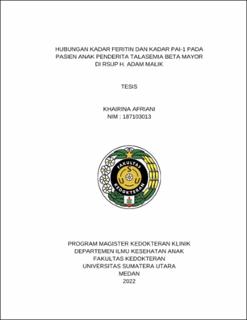Hubungan Kadar Feritin dan Kadar PAI-1 pada Pasien Anak Penderita Talasemia Beta Mayor di RSUP H. Adam Malik

Date
2022Author
Afriani, Khairina
Advisor(s)
Rosdiana, Nelly
Pratita, Winra
Metadata
Show full item recordAbstract
Background: Serum ferritin level is a routine check to monitor iron overload
in thalassemia patients. Iron overload due to transfusion can lead organ
damage, such as causing vascular damage which is at risk of reminding the
incidence of thrombosis. Patients with thalassemia frequently have increased
plasminogen activator inhibitor-1 (PAI-1) levels from the side effects of blood
transfusion, such as vascular complications like inflammation, vasculitis, and
thrombosis. There may be a relationship between serum ferritin level and
serum PAI-1 level.
Objective: To determine the relationship between serum ferritin level and
serum PAI-1 level.
Methods: An analytical cross-sectional study was carried out to thalassemia
patients who receiving routine blood transfusions in Haji Adam Malik hospital,
Medan from May to June 2021. Serum ferritin and PAI-1 levels examinations
were carried out through blood sampling. Pearson and Spearman correlation
tests were used for normal and abnormal distribution data analysis. Statistical
test with p <0.05 was considered significant.
Results: The lowest ferritin serum level was 445.86 ng/mL and the highest
level was 12836.44 ng/mL. The lowest PAI-1 serum level was 0.12 ng/mL
and highest level was 10.76 ng/mL. There was no significant relationship
between PAI-1 serum level and serum ferritin level (p=0.454). Age,
transfusion length, and transfusion volume were significantly correlated with
PAI-1 levels with positive correlation value.
Conclusion: No significant relationship between serum ferritin level and the
increased in serum PAI-1 level. Age, transfusion length, and transfusion
volume were significantly correlated with serum PAI-1 level.
